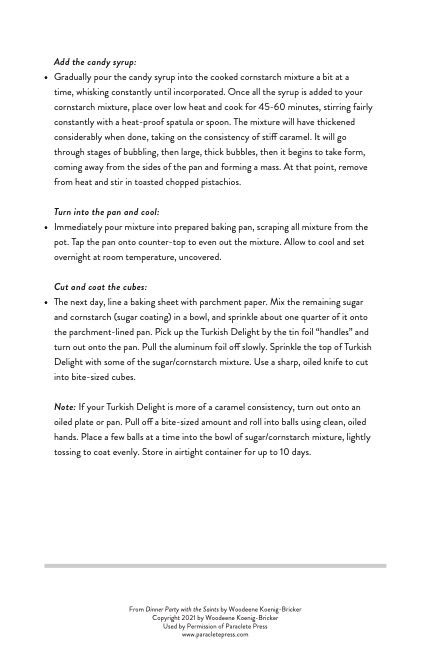Prepping for Easter: Pomegranate & Pistachio Turkish Delight

I know we are only on the Second Sunday of Lent, but it doesn’t hurt to plan ahead. That’s why I’m grateful to Woodeene Koenig-Bricker for providing today’s guest post and recipe from her newly released book Dinner Party with the Saints. Enjoy!
One of my favorite sweets is Turkish Delight. I’m not sure how a girl who grew up on the side of a mountain in Montana ever came to taste it, but I’ve loved it for as long as I can remember. When I visited Turkey as an adult and had the “real” thing from the market in Istanbul, I was over the moon. I swear I could live on the stuff!
As I was writing the story for Dinner Party with the Saints, I knew I had to include Lydia of Thyatira, not just because she was from Turkey (did I mention how much I love Turkish Delight?) but because my middle name honors my aunt Lydia, my only aunt on my father’s side. But all that aside, Lydia in the bible was a gutsy, successful, wealthy businesswoman who held her own in an argument with St. Paul as well as being the very first Christian convert to Christianity in Europe. She was just the kind of person I wanted to introduce to the world, not merely as a few lines in the bible, but as a person I would talk with at a dinner party.
When Celia and I discussed what sort of food Lydia would bring to the event, Turkish Delight was the obvious choice. Although Lydia herself might not have eaten the sweet, the ingredients would have been available to her. I like to think she might have enjoyed a piece or two as she chatted with Paul on the riverbank about Jesus, faith, and the role of women in this new movement.
As an interesting footnote, because Celia lives in Maine and I live in Oregon, it wasn’t possible for me to taste the foods she was preparing, but she sent me a box of Turkish Delight that I hoarded like a dragon hovering over a stash of gold: “No, you may not have a piece!” I can attest that it is fabulous. Because it keeps quite well, it would be possible to make it during Lent and save it to eat at Easter. For me, the saving part would be more than enough Lenten penance.
The goal of Dinner Party with the Saints was three-fold. First, I wanted it to be a fun read. I wrote the story I would have liked to read myself. Second, I wanted to introduce the real people behind the pious hagiographies. Instead of plaster statues of impossibly good people, I wanted to show that saints are just as human as the rest of us. It’s their desire for holiness, not their inherent goodness, that sets them apart. And finally, I wanted to give people something practical to link to the saints—hence Celia and her fabulous recipes. If, for instance, people think of Lydia, her dealings with Paul, and her example of being a strong, independent woman when they eat Turkish Delight, I will have succeeded beyond my hopes.
The saints represent all eras of Christian history, as well as cultures from the around the world. I think of it as a bit of a history/travelogue/hagiography/cookbook as well as a story! So, here’s to all the saints and our common journey to holiness through our shared experiences including good food and drink. May we all meet at the Eternal Banquet.
See below for the full recipe:


